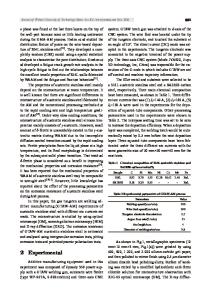Microstructure Development of 308L Stainless Steel During Additive Manufacturing
- PDF / 3,729,280 Bytes
- 16 Pages / 593.972 x 792 pts Page_size
- 36 Downloads / 338 Views
UCTION
METAL additive manufacturing is a rapidly developing processing pathway that produces components by selectively melting and solidifying feedstock to build a desired geometry, rather than subtractive machining from cast or wrought material.[1] The difference in microstructures between additively manufactured (AM) and wrought components can be substantial, similar to the changes observed within welded microstructures.[2] This is significant because, in general, the options for post-build manipulation of the microstructure of AM components after fabrication are limited. Also, AM frequently results in large residual stresses in the component due to the rapid cooling and associated thermal gradients. Again, this is important because the residual stresses can drive distortions (or even fracture) during and after the build resulting in build failure or completed components outside of geometrical specifications.
D.W. BROWN, A. LOSKO, J.S. CARPENTER, J.C. COOLEY, and B. CLAUSEN are with the Los Alamos National Laboratory, Los Alamos, NM 87545. Contact e-mail: [email protected] J. DAHAL is with the Department of Mechanical Engineering, Colorado School of Mines, Golden, CO 80401. P. KENESEI and J.-S. PARK are with the Argonne National Laboratory, Lemont, IL 60439. Manuscript submitted November 19, 2018.
METALLURGICAL AND MATERIALS TRANSACTIONS A
Studies of the post-build microstructure[3–7] of AM material and/or residual stresses[8–15] in AM components abound. However, very few in situ studies of the development of the microstructure, distortion, and residual stress have appeared to date.[16,17] In situ X-ray diffraction and imaging during AM offer the ability to glean information about the microstructure during solidification and cooling, especially given the recent gains in data collection rate at third-generation synchrotron sources. Perhaps the first relevant study was reported by Elmer et al.[18,19] during deposition of a weld bead on a rotating drum, but the relatively low X-ray energy limited the experiment to information close to the surface of the weld. More recent in situ imaging studies[20] provide valuable information about the melt pool geometry and solidification rate but little information about the microstructure. A recent diffraction study[21] with very high time resolution during rapid solidification approximating AM conditions provides information about liquid and solid phases present. However, quantitative microstructural information, e.g., crystallographic texture, phase fractions, internal stress of the solidifying, and cooling material, is not determined from the data presented.[21] This work reports in situ high-energy X-ray diffraction studies during wire arc additive manufacture (WAAM) of 308L stainless steel. Of all of the AM techniques, WAAM was chosen for several reasons: (1) It is relevant to repair weld technology, (2) the cooling rate is orders of magnitude lower than laser powder bed
fusion resulting in time scales more amenable to in situ measurements, and (3) the safety considerations of in si
Data Loading...











